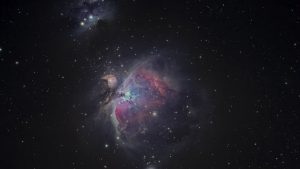Jupiter’s Moons Io and Europa Captured by NASA’s Juno During Recent Close Flyby
NASA’s Juno mission made its 39th close flyby of Jupiter recently and captured an incredible image of the planet’s southern hemisphere. However, a closer look at the image also revealed two more heavenly bodies nearby — Jupiter’s moons Io and Europa. Juno made the close fly in mid-January this year but NASA released the image last week. At the time this image was taken, Juno spacecraft was about 61,000km from Jupiter’s cloud tops, at a latitude of about 52 degrees south. It sent the raw data to the ground-based control and citizen scientist Andrea Luck created the image using that data.
Jupiter, the solar system’s largest planet, has 53 named moons and another 26 awaiting official names. The rocky moon lo is the most volcanic world in the solar system, but Europa’s icy surface hides a global ocean of liquid water beneath. Juno will have a closer and more detailed look at Europa in September this year when it makes the closest fly-by of the enigmatic moon in decades.
Juno will also make close approaches to Io in late 2023 and early 2024, NASA said. NASA has made available raw images captured by JunoCam so that citizen scientists like Luck can peruse and process the data into image products.
NASA said Io’s intense volcanic activity is a tug-of-war between Jupiter’s powerful gravity and pulls from two neighbouring moons — Europa and Ganymede. Io, the third largest of Jupiter’s moons and the fifth in distance from the planet, is a bit larger than Earth’s Moon.
Europa, on the other hand, is the most promising candidate to find an Earth-like environment to support life. Scientists believe it has hidden a salty-water ocean beneath its icy surface. That ocean could hold twice as much water as Earth’s oceans combined.
NASA launched the Juno spacecraft on August 5, 2011, on a 5-year journey to Jupiter. After covering a 1.7-billion-mile journey, it arrived at the planet on July 4, 2016.



